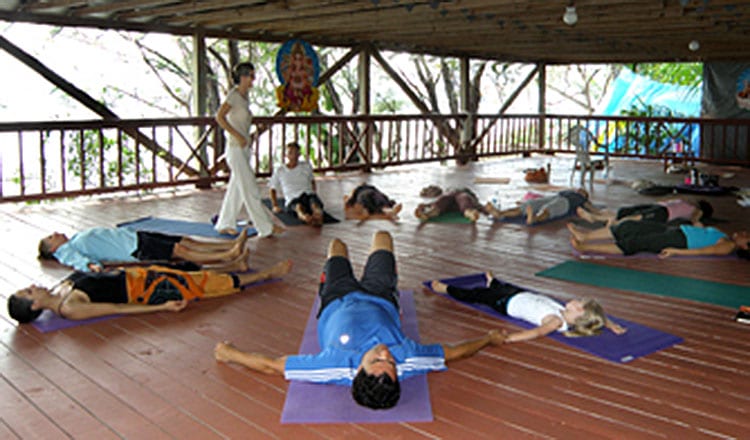Sivananda Bahamas Blog
Expand Your Horizons …
Our Blog
Teaching Yoga and Relaxation to Children, by Mira Binzen
"Why practice yoga?" I asked the children at the beginning of our yoga class at Bloom Yoga Studio last week. "How do you think it helps you?" Hands shot into the air. A six-year-old boy wearing new Harry Potter glasses went first. He stated matter-of-factly, "Yoga clears your mind and relaxes your body." All the children in class gave a response. Most mentioned the way it helps them relax and how it helps regulate moods and energy level. The children feel this every week in class and incorporate it into their daily life.
There are several ways that yoga clears the mind and relaxes the body. One of the most profound is the final relaxation at the end of each class known as savasana. The Sanskrit word "sava" means corpse. We call this pose "final rest." Virtually all children mention this practice as their favorite part of class. They love crow pose and all the games we play, but what seems to resonate most with them is the opportunity to relax deeply at all levels.
Time spent in stillness at the end of each yoga practice is a key element in assimilating the benefits of the practice. It is important for the body and mind to have a chance to process and integrate the experience--to file it all away. Just like cleaning up after a party or making a big meal in the kitchen, your mind and body need to clean up and reorganize.
Children benefit from this deep rest not only at the end of yoga class but also throughout their day. I remind the kids they can rest like this after a birthday party, when they get home from school, after playing outside before dinner, or anytime they are transitioning from one activity to the next. Parents know that it is during transitions when most meltdowns occur, so encouraging a rest break may help prevent them. Kids learn to brush their teeth, pack their bags for school, and set the dinner table. They can also learn to take 10-minute rest breaks during the day.
Final rest has several stages to it. First relax the body, then the breath, then the mind. Here is an example of how I facilitate this in my classes. You can adapt it to the classes you teach, at home with your kids, or for yourself.
To begin, hold a clear intention. This has a bigger impact than you may think. It is much more likely that the children (or you) will rest still and quiet if it is intended to be so. Even when children are squirmy, I spend the full rest time creating a situation in which they may be able to settle.
Reduce sensory input. Dim the lights, eliminate sounds as much as possible, and cover the little ones with blankets. The weight of the blanket is soothing to the nervous system and muffles sensory input to the skin.
Shake out tension. As the children settle in, I walk around the room and give each child the "noodle test." It works on a couple of levels. First is the enticement. I announce that I will give the noodle test to whoever is lying still and quiet on their mat. This works like a charm since 98% of the children do indeed want the noodle test. I pick up their legs and wiggle them just a bit to check that they are as soft and limp as cooked noodles. Then I check the arms. If a kid is holding tension, I keep wiggling gently until there is a softening. Then I say, "There it is. Can you feel it?" This helps them develop the felt sense of limp limbs to recall the next time they relax.
Cue deeper breathing. I more or less sing in a soft voice: "innnhaaale. exxxxhaaale" to set the pace for deep belly breathing that will trigger the "rest and digest" response of the autonomic nervous system. I may do this a couple times, or several times as needed through out the final rest. Children generally love to be sung to, so if you have a lullaby-type song about the breath, go for it! This will become part of the ritual that helps them relax.
Guide the mind to a relaxing place. The mind is a pretty impressive piece of equipment. It will go on churning out thoughts faster than the 12 cores of processing power in a new Mac Pro. To rest deeply, the mind needs to be gently directed to the kinds of thoughts that send a message to the nervous system to relax. How does your body feel when you read this: "Driving fast on an unfamiliar icy road in the dark"? How about "taxes due, bills late, have to change dentist appointment, need groceries"? Versus this: "Warm soft sand, a still lake, the fresh scent of a spring garden, an open expanse of blue sky." This is the part I call "relaxing stories." There are several resources to get you started. One is a book of such "stories" called Spinning Inward by Maureen Murdock. There is also a CD of guided relaxations called, "Chill Children" by Global Family Yoga (full disclosure -- it's me!).
Lying still underneath a snuggly blanket with the lights low will have no effect if the mind is not brought into a state of calm. Scientists call this an alpha brain state. In this state, the mind is creative, expansive, and open to insights. It's worth the time to get our kids -- and ourselves -- into this state on a daily basis.
Spend several minutes creating mental imagery for children, then allow several more minutes of silence. Silence is important. It allows room for the mind to loosen out of the time/space continuum and into spacious awareness. After this silent rest, talk them mentally back through the imagery in reverse order. Suggest the felt sense of the body on the floor and remind them to notice their breath to reorient to their current time and place. Moving from deep rest back into a more active engagement with the world is a transition in itself. Children tend to spring up, which can be jarring. Encourage them to move slowly, like a sloth, respecting where they have been and where they are going next.

Mira Binzen is an advanced Sivananda Yoga teacher and a yoga therapist. A highly experienced teacher of children’s yoga, she holds a degree in child psychology and is the founder of Global Family Yoga, an organization that focuses on child development through yoga.








